Planning ahead means getting into shape, collecting the bare necessities packing list, and planning when, how, and for how long you will manage your Camino de Santiago.
If you can afford and plan to use hotel accommodation, restaurant meals, and luggage carried then this route report is not for you. In our five Caminos between 2006 and 2015, we stayed in albergues, cooked our own or shared meals, and carried our own backpacks. Our last Camino we were 72 and 77 years old and it took us 44 days of walking compared with between 30 and 33 days earlier.
We flew from Vancouver to Gatwick with Air Transat and out of Stanstead with Ryanair or Gatwick with Easyjet to Biarritz – the best airport for the start of the Camino Frances. The disadvantage of this was that many flights arrive in Biarritz too late to catch the last train from Bayonne to St. Jean, so twice we stayed in Bayonne, catching an early train the next day. In Bayonne, we could stock up on picnic fare for our crossing of the Pyrenees or if the weather was bad, via Valcarlos.
When we did arrive late in Saint Jean Pied de Port, not much accommodation was left and once we did book ahead with L’Esprit du Chemin, who kept dinner waiting for our late train. The Pilgrim Office may be closed for dinner when you arrive but will be sure to open later to make sure all pilgrims are accommodated, even if it means on the gym floor of the school.
Before we left we practiced walking with our hiking boots and packs at least 20km especially up and down hills. We picked September/October to be able to harvest most of our garden, though I believe April/May is also considered ideal. Summer is hot and busy and winter can mean snow on the mountains until March.
Our boots were well broken in and we carried comfortable hiking socks and inserts (cotton or polypropylene inside wool), comfortable quick dry underwear including long underwear for sleeping and cold weather, two pairs of zip-off hiking pants, two quick dry tops one long and one short sleeve, a fleece jacket, rain jacket, and pants or good poncho and backpack cover, a hat for rain and for sun, sandals for town or the shower and a good headlamp for walking in the dark. Some pilgrims also carry street clothes, but we didn’t bother. We had lightweight sleeping bags, washing gear with quick dry towels, a first aid kit, and medications. The hospitaleros do carry good first aid materials and most villages have well equipped pharmacies. We don’t carry a cell phone, camera, or computer but some do and there are plugs for recharging in most albergues. We used the computers in the albergues, libraries, tourist offices or municipal building we passed through.
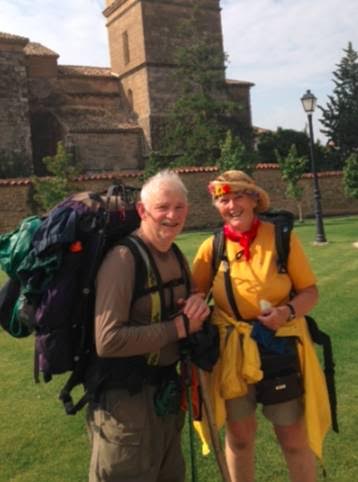
All our essentials go into zip locks in our neck pouches which we guard carefully: Pilgrim Passport, passport, tickets, and extra cash.
Large places have banks and cash machines, but smaller places take only cash so we carry small bills for food and accommodation. Some accommodation is listed as “Donativo” and we pay whatever is fair. One place closed down because pilgrims taking advantage meant they had no money to repair the roof. At Rabanal, however, they were able to put solar panels to heat the showers because pilgrims were more generous. We tried to stay in “parochial”, municipal, as well as many private and generally paid between 7 and 15 or more euros per person for a bunk bed with showers and sometimes a kitchen – a real bargain. We always tried to leave the albergue and the hospitalero with a good impression. Many are volunteers and they all take very good care of us.
There are places where it’s worth or essential to book ahead. If we decide to stay in Bayonne, we book a hotel near the station, we have booked in St. Jean, but the Pilgrim Office will find a place too. In 2015 we decided to split the climb up the Pyrenees by staying in Kayola (or Orrison) and booked that stay. Now we read that one needs to book Roncesvalles, (www.albreguederoncessvalles.com/reservas.php), where you can also reserve meals as well as a bed.
We always tried to arrive at each destination by 2 pm to be sure of getting a bed. The routine is to park one’s backpack in order outside the door if you decide to explore or shop before it opens. It is a good idea to shop then since Spain does have a siesta in the afternoon. If the albergue is full the hospitalero may phone around to find you a place or may give you a mattress on the floor.
Three times we have climbed the Pyrenees, once in 100kph gales, but the views are well worth it. Twice we went through Valcalos because of bad weather. Both arrive in Roncesvalles if you leave early in time for the 4 pm opening. The next day in the Basque country is also beautiful but not so steep. The route to Pamplona is green like Galicia, crossing rivers and through beech woods. Once, we stopped at Larranosana, which has no shop, but usually we stop at Zubiri which has several.
Day three ends at Pamplona. Sometimes we have moved on the Cizur Menor to stay with Roncal, the place with the lovely garden. Once we stayed at a German run albergue in a park called Paderdorn, but our favorite was the cozy convent at Trinidad de Arre on the bridge before Pamplona.
Then up the hill to Alto de Perdon by the windmills and steeply down the other side to Puente la Reina where our albergue is run by the Padres Reparadores which also has a nice garden. Though once when we couldn’t get in we had to move on the municipal albergue at Cirauqui – a long day and up a steep hill.
All five times we’ve enjoyed the municipal albergue at Estella at the entrance of town. But we always made sure to explore the rest of Estella with its lovely churches and Town Square where families gather in the evening. Three times we stopped at Isaac Santiago in Los Arcos, but twice we went on to Casa Mari at Torres del Rio. But once all that was left were mattresses on the kitchen floor. But Mari had stocked her refrigerator and cupboard with zucchini and tomatoes for everyone to share.
The last town in Navarre was Viana where we stayed in Andre Munoz. Some prefer the albergue with the nuns who provide a meal but one sleeps on mats on the floor. In 2015 we were lucky enough to arrive on a Saturday during a fiesta with music, fireworks, and Running of the Bulls through town. What amazed us was that children dressed in white letting off firecrackers stayed so clean!
Then on to La Rioja through vineyards to Logrono where we cross massive community gardens. We stayed there once but mostly hike on to the hill town of Navarette, the river town of Najara and the village of Ventosa.
Then on to Azofra where the popular albergue has two beds to a room and a beautiful kitchen and dining hall. Once we stopped at Redecilla to avoid the rain, once to Granon where the choice was either the Bell Tower with communal meals and mats on the floor or a private albergue with paid meals. The Pilgrim Menu is usually soup, sometimes meat but often vegetarian main meal, bread wine, and a light dessert. Our favorite stop in La Roija has been the lovely Casa del Santo at Santo Domingo.
Next towards Burgos. From Redecilla we stopped at Villafranca Montes de Oca at the old schoolhouse. Four times we stayed at Belorado with the storks on the church roves, three times at the private Quatro Cantones with a swimming pool in the garden, and once (our favorite) at the cozy Parish Hostel run by the Swiss Association near the entrance of the city. Before Burgos is the lovely wilderness of Atapuerca renowned for its ancient people. We picnic in San Juan de Ortega then head to the private albergue in the village of Atapuerca. There is now a shop in the village. Each time there we were greeted by the same lovely hospitalera.
From Atapuerca we have stayed either in Burgos or on to Tarjados. The first Municipal albergue was in the park, but it now sits up the hill behind the cathedral. But in 2015 we managed to find the lovely Divina Pastora Albergue and stay the night. In Tarjados the municipal albergue does not have a kitchen but we have brought picnic supplies from Burgos and the hospitalero leaves a thermos of coffee and some cookies for the morning.
We have never stayed in San Bol, but a friend who has loves it for its peacefulness. We love walking in the early mornings for the peacefulness walking in the dark (with headlamps when needed) with Orion on one side and the Milky Way on the other. But we have to turn around to enjoy the sunrise.
Our next stops have been either Hornillos or Hontanas both with a single street downhill typical of villages in the area. This is sheep country and we have enjoyed watching massive herds returning to the barns after spending all day grazing on the already harvested wheat fields. Next on to Castrojeriz once staying in the private albergue of Casa Nostra, once in a beautiful Casa Rural when all the albergues were full, and finally in the comfortable San Esteban at the end of the village. The next stage is up and down the steep Alto Mostelares with a very welcome van at the top selling drinks and fruit.
Into Palencia where we stayed twice in two different albergues at Boadilla, once at Itero de Vega, once at Poblacion de Campos and twice at Fromista. This is irrigation canal country where sheep graze the harvested fields in fall. Once we watched while a shepherd and his dog herded a flock from one field to another when a sheep fell into a well and had to be pulled out by his shepherd none the worse for its fall. In Fromista we discovered a cake shop selling enormous white cakes large enough to be shared by three or four pilgrims.
One of our favorite towns on the Camino is Carrion de Los Condes where we stayed at the Santa Maria Albergue with the singing nuns. They welcome us with tea and treats and invite everyone to share a meal and a sing-song. There is a park by the river where we once joined a Policeman’s’ Picnic and once we joined a wedding in the church where the bride arrived by horse-drawn carriage. Happy memories.
Our next destinations were usually Ledigos, Terradillos, or San Nicolas, but in 2015 we needed to stop earlier at the lovely municipal albergue at Calzadilla de la Cuerza – spotless and with a most helpful hospitalero.
Next the province of Leon where at Sahagun we’ve stayed at La Trinidad. A very interesting town to explore with lots of history. But three times we’ve moved on to the farming village of El Burgo and the popular albergue called Domenic Laffi. After that, we’ve once, because of heavy rain, stopped at Religios at a private albergue called La Parada. But we usually head for the municipal albergue in Mansilla de las Mulas run by the very helpful Laura.
Next into the city of Leon where the Benedictine nuns run a large albergue and provide breakfast every morning. But be sure to return by 9:30 or the doors will be locked! Beyond Leon, we head straight for Villadangos where they will if you wish serve a lovely communal meal. Then we head for Orbigo with its Jousting Bridge and the friendly artistic San Martin. But our favorite walled city is Astorga and the spotless Servias de Maria Albergue on the way in. All rooms are small and spotless and there is a terrace overlooking the countryside around. The Gaudi Palace, the Cathedral, the Chocolate, and the Roman Museums and the walls are all well worth a visit.
Twice we’ve climbed to the ruined village of Foncebadon to stay. It is gradually being rebuilt slowly. Once we stayed at the rebuilt church and once at a vegetarian albergue where we celebrated a birthday with a Beatles’ Party. But three times we stopped at Rabanal at Gaucelmo where the lovely hospitaleros serve tea and breakfast and have an herb garden, orchard and a library with a fireplace. Since installing solar panels they have the best showers on the Camino Frances.
Downhill from Cruce de Ferera is a very difficult scramble. We have made it to Molinaseca and even to Ponferrada, but in 2015 we stopped at Riego de Ambros to give our knees a rest. In Molinaseca we suggest the private albergue must be better than the municipal one where we stayed, though in summer you can sleep on the deck.
The road to Ponferrada is a sidewalk unless you take the longer route through the countryside which we did once and got lost! But the San Nicolas Albergue is welcoming with living, dining and kitchen areas and a garden.
In 2015 we made it only to Cacabelos before stopping at the church albergue with its double rooms and stayed for two nights because of illness. Our usual destination was Villafranca del Bierzo on the Valcarce River where we stayed at the municipal albergue. A friend enjoyed her stay in Pieros at a private vegetarian albergue el Sabal y la Luna where she was asked and agreed to stay and work for a week.
Along the Valcarce valley, we have stayed at Pereje’s municipal albergue, (not recommended), Vega del Valcarce Municipal, (friendly), Trabadelo’s private Crispeta, (excellent), Herrerias private vegetarian, (excellent) and our very favorite La Faba run by the German Association. Then the steep climb up to O Cebreio, near Villafranca del Bierzo, which some pilgrims reach on horseback!
In Galicia even though many albergues have kitchens, they do not always stock them hoping that pilgrims support the local restaurants instead. The municipal albergue at O Cebreiro is one of these. Sometimes we have hiked on to Hospital de la Condesa a renovated schoolhouse further on. Another pilgrim stayed in a private albergue at Alto de Poio where they had hunted a wild boar which they barbecued for dinner. She said it was delicious. Our stops at Alto de Poio have been for a second breakfast with the tastiest honey we have ever tasted.
Next stop is usually Triacastella where Aitzena is our home for the night. It has a beautiful living-dining area, a small well-stocked kitchen and even a bathtub hidden away. Twice we’ve taken the route to Samos. Once we stayed in the monastery one huge room with murals. Better is the new private Val de Samos with cozy duvets and a well-equipped kitchen. Then on to Sarria which, because it is about 100km from Santiago, is the starting point for many pilgrims!
In 2006 we passed on to the village of Barbedelo to stay in the municipal albergue there, but usually, we have stayed in the private Don Alvaro in Sarria with a lovely garden, equipped kitchen and even a sitting room with a fire. In 2015 we discovered the Monastery de la Magdalena at the top of the hill out of Sarria which became our very favorite place.
There is a very long hike to Portomarin where we usually stayed at the municipal albergue until we discovered the well equipped and very friendly private Ultrea. Portomarin often has evening entertainment with pilgrims and locals in the squares and arcades. Once farmers were stomping grapes in a tub on a trailer and they shared grapes with us.
Up the long hill out of Portomarin we have stayed both at Gonzar and at Ligonde with a group of American missionaries who rebuilt an old barn. But this has since been closed. At Palas de Rei we discovered San Marcos near the church of the same name – very cozy with a living area, garden, and kitchen where you can buy breakfast before you leave. Once we stayed at Casanova’s Municipal Albergue, but mostly we head on to Melide where both the municipal and the private Pereira are good. Once we stayed at the oldest albergue on the Camino at Ribadiso, but the washrooms are down the garden so this is not convenient for us oldies!
In Arzua we have usually stayed in the convenient municipal albergue but in 2015 discovered that the old shoemaker’s shop on the way out has been converted to a lovely private Albergue da Fonte- friendly comfortable and well equipped. Weather permitting our favorite activity in every town and village has been to find where the local folk hang out and enjoy all the activities there.
Arca do Pino has a lovely municipal albergue but has been treated badly by many of the pilgrims who have partied and destroyed all the kitchen equipment that was there earlier maybe because it is the last stop before Santiago. In 2006 we heard all the noise and were dismayed to see the damaged kitchen in the morning.
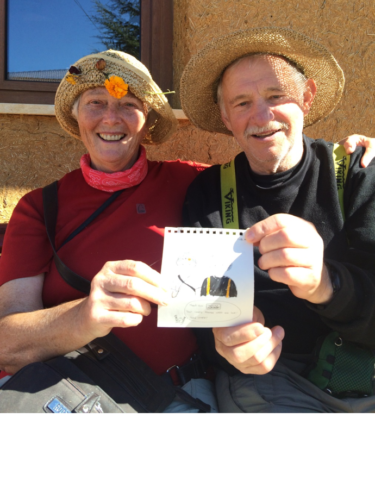
Twice, we have stayed at Monto do Gozo, where we were allowed three days. But in 2015, it had been turned into a homeless shelter. We never saw homelessness in Santiago de Compostela, but friends showed us their favorite Albergue Acuario on the way into town and near the bus station and shopping centers. Friendly hospitalera and a lovely well-equipped kitchen. So we leave our packs there before heading into Santiago to get our Compostella and visiting the Pilgrim Office to print out our boarding passes and meet other pilgrims.
Another friend once stayed at the lovely Albergue at St. Martin de Pinerio, which is also a high-class hotel. We usually stay for three days in Santiago, which has many lovely places to explore. We are always sad to leave Santiago and say goodbye to the many friends we have met. We always collect e-mail addresses and have kept in touch with pilgrims we have met along the way.
This post was written by Natasha Fiket from Canada. Natasha and her husband, Vic, have walked the Camino Frances five times since their retirement.

I love hiking, backpacking, and camping. From the Camino de Santiago to the West Highland Way in Scotland or simply a great day hike on the weekend. Hiking refreshes me, my mind, and keeps my body reasonably fit. So far I have walked three Camino routes and many other long distance hikes in the UK, Canada, and around the rest of Europe. One of the best was my hike up Ben Nevis.

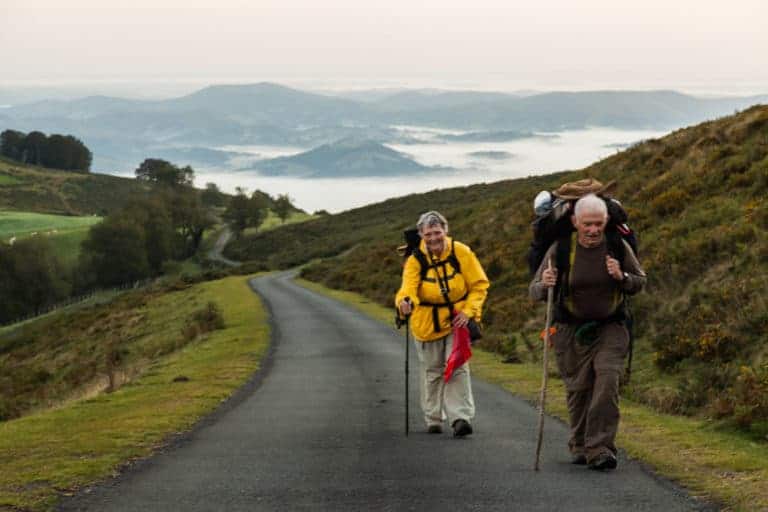
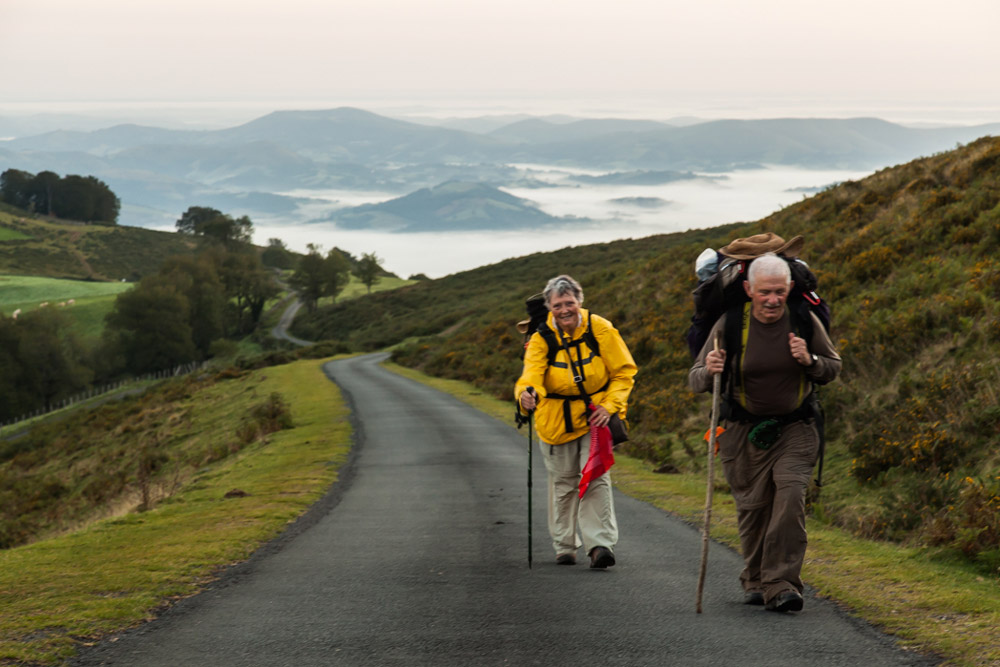
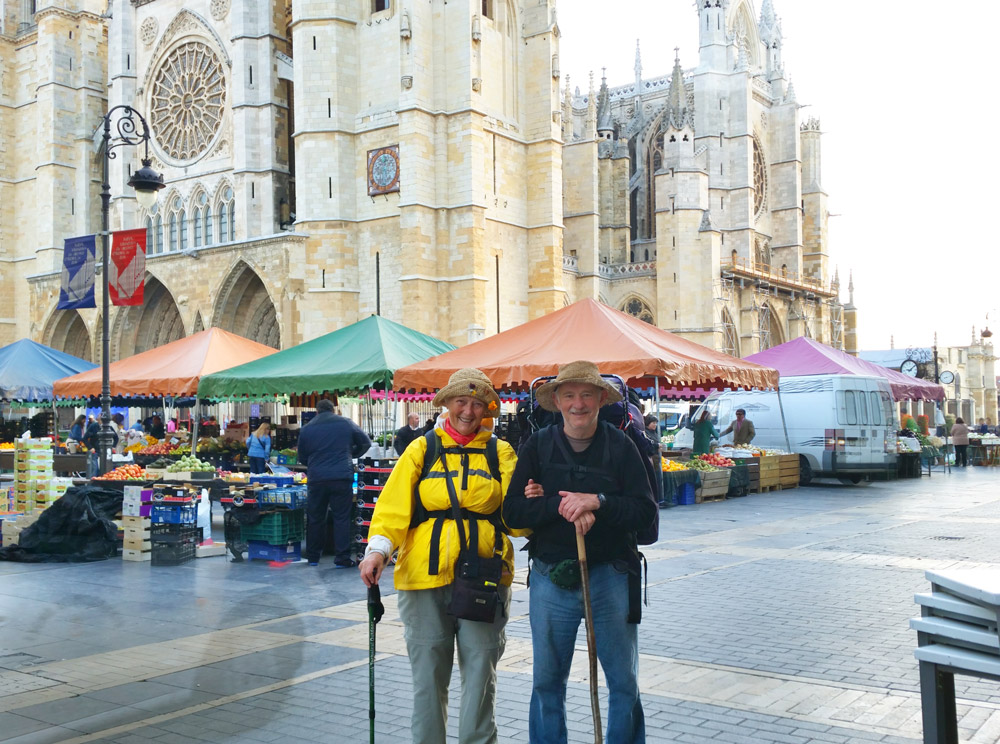
Natasha! Thank you for your beautiful diary! I hope to one day also walk the Camino. I am 66 and you give me inspiration to keep my dream alive! God bless you!!
That was a lovely Post. Thank you!!
Cathy, 68 and David, 75
Sitting here in Melbourne Australia on a windy cold winter morning, coming out of our 4th lockdown (hopefully), your diary has given me such heart that one day not too far away we will do this. You make it sound so possible, good planning and taking time to truely enjoy where you are. Thanks Natasha. Kris 71
Great story! God bless. will be turning 70 this coming Oct. so i guess even with my weak legs might be able to once again do the Camino. Retirement does give you that special time to enjoy.
very inspiring, i plan on walking the pourtuguese route next year. I’m in my seventies.
Margaret Fay
Thank you Natasha, really enjoyed your diary, especially tips about vegetarian fare. We have had some difficulty on our 3 Camino’s.
We will be 70 by the time we can leave Australia again, but we are fit and have kept up our walking hoping our future holds more Camino walking.
Cheers from Australia 🇦🇺
Started to read this article, but stopped when I got to the statement in the first paragraph, “…If you can afford and plan to use hotel accommodation, restaurant meals, and luggage carried then this route report is not for you.” I took him at his word and stopped right there.
My wife and I walked the Frances Camino in 2016 when we were 68 & 67. We did carry our own backpacks, but we stayed at a variety of places —- albergues, pensions, small hotels, and even a couple of times at four star hotels. We took our time (46 days), enjoyed the peace, people, food, and spiritual awareness that we shared. I guess my point is that you don’t have to travel on a shoestring (I’ve done enough of that in my life) to appreciate the intrinsic value of the Camino.
Ditto David. I have completed 5 caminos and completely agree with your comments. I’ve mostly walked on my own and always carry my own backpack and the first 2 times I stayed in albergues. I am really grateful for what the albergues offer, but I now prefer to stay in cheaper hotels and also treat myself to 4 star hotels if and when I want. Buen Camino.
Hi David
I am a fit 72 young lady! And hope to walk the Camino in September. Having read lots about the pilgrimage, I think I want creature comforts along the way. Is there a good site to help me plan for this?
Rhona from Amelia island
Thanks for that. I feel the same. Haven’t done it yet but plan to in the near future.
Thank you so much for your wonderful descriptive travel journal. It takes me back to 2000 and my own Camino, and jogs my ageing memory. You look to be truly happy on the photographs and I think that is how walking the Camino makes you feel in spite of the challenges! And, it changes your outlook on life forever.
Thank you very much for your story. It’s nice to remember places and events. I walked the Camino Frances in April 2017, alone at the age of 58. I didn’t think about my age for a moment, because everyone has their own pilgrimage in time and place. I only use albergues. Weather conditions ranged from +20 degrees to snow and wind. It is a test both physically and mentally. Also because I eat vegetarian, but at the beginning of spring there was almost no fresh fruit. After a 2-week walk, I stopped in a small country cafe in exhaustion and the owner, looking at me, said: You have to love yourself more when you walk the Camino. It was like a stone on my forehead to make me understand that I don’t have to rush anywhere, because I can’t miss anything. If the Camino calls me again, I would also go together with good friend. Buen Camino!
I am hard at planning and physically preparing to walk the Camino in 2023 in late June-to July. Plan to not use luggage carriers.I will be 82 just before I start. Other than atrial fib (I will have my meds) I am healthy, eat properly, not fat, and have done the UK c to c twice.
Any advice?
Bob Fitzpatrick
The best advice I got, was to take it easy and listen to my body. I slowed down and had less pain.
Walked the Primitivo last year at age 74. It was my fifth Camino–Frances twice; Norte; Portugese before. Planning to walk the Sabnabres in September at 76. NEVER pre-book and carry my own pack.
Sad to see many people quit because they realize the Camino is nothing but a joke to those who pre-book and have taxis carry their expensive, light weight backpacks.
Albergues–on Primitivo, municipals albergues had dozens of empty beds while pre-book places were full. If people fail to use the municipal albergues, we are going to lose them.
And the walk to Finisterre from Sanitiago is GREAT! A real treat after walking with the commercial tourist circus that started at Sarria.
BTW, some sites are now giving information how to walk from Sarria to Santiago without walking with the CROWDS on the France Camino.